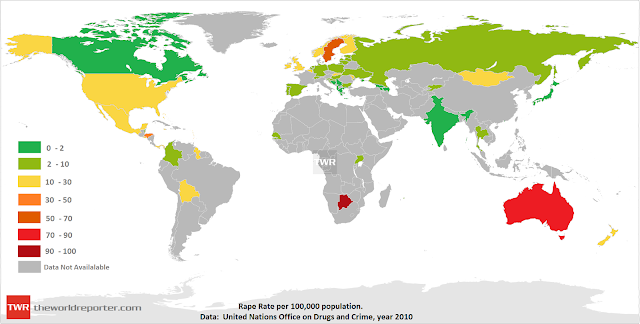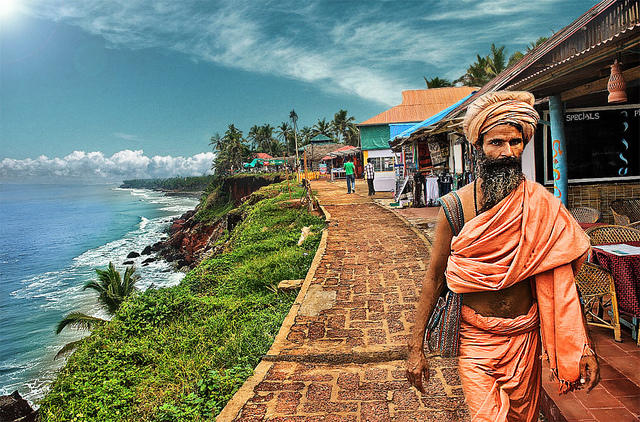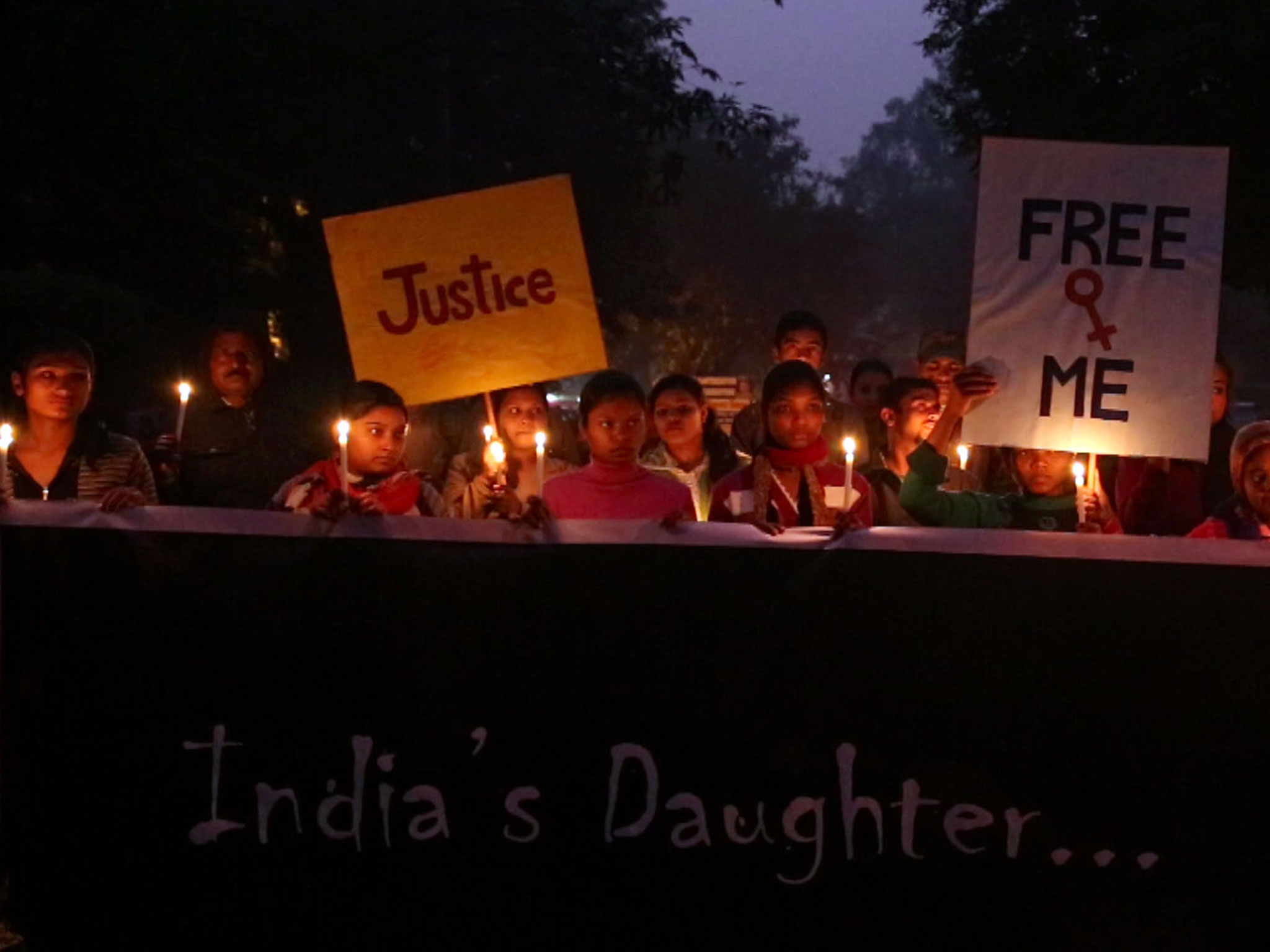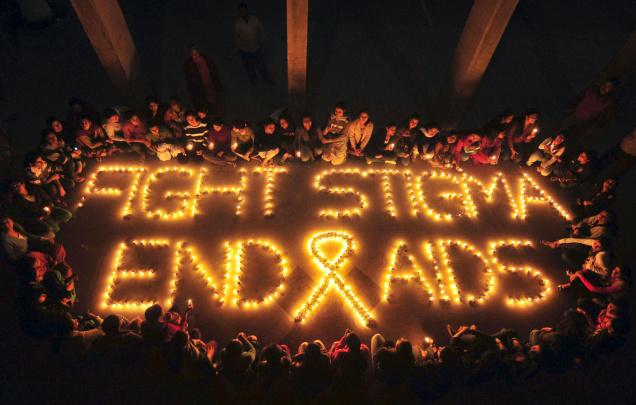Women
Increase in Rape Cases, How Should We Tackle Violence Against Women?
The whole nation was in an immense distress when a 23 year old medical student was raped at night in a tinted window private bus in a posh colony of New Delhi. The incident resulted into a robust response from the public and the youths. Peaceful protests were held throughout the nation in the major cities demanding justice to the victim and asking for giving the toughest punishment ever to the abusers. The news became international and since then Delhi has been highlighted so notoriously that whenever something like this happen, we at India get calls from other TWR centres, asking us what is this happening? The people over there have gone out of control.
 |
| Rate of Rape per 100,000 population, click to enlarge. |
United Kingdom, for instance recorded 85,000 cases of rapes in the year of 2006 as reported by BBC One. British Crime Survey report stated that only 800 people were convicted of rape crimes that same year, 2006, which illustrates that less than 1 in every 100 rape survivors were able to convict their attacker. Today the condition in UK has become worse compared to 2006, but police, public and the government take this burgeoning problem really seriously. A long term approach was chosen and a number of campaigns like This is Abuse by Home office, Time to Stop rape campaign by Norfolk and Suffolk Constabularies, Rape Shatters Lives campaign by Cheshire Constabulary, Safer Relationship by South Wales Police and similar campaigns by the police departments of Metropolitan Police, Lancashire Police, Hertfordshire Police, and Lincolnshire Police were launched to check the crime by spreading awareness. The police also started short term programs which includes:
– Managing offenders
– Delivering effective investigations and CJ outcomes
– Reducing vulnerabilities (of victims)
Apart from these, many public and non profit organizations started online and poster campaigns spreading awareness about women freedom and why men should not rape. A number of such organizations set up low cost 0800 and 0333 number, which is low cost helpline numbers dedicated to non profit organizations and charities.In South Africa, rate of rape is extremely high and the reason of this is completely different than what it could be in UK, US, or India. One of the reason of high number of cases in South Africa is HIV. Yes, it should be other way round, high number of HIV positive cases because of high number of rapes. But in South Africa there is a myth that having intercourse with a virgin would cure HIV infection and will free the abuser from HIV virus or AIDS. This has led to increase in child abuse and rape. Similar kind of myth also remains in other countries in the southern part of the continent Africa which can be easily observed on the maps.
In India general culture is changing, men and women are realizing their freedom and rights and they enjoy in late night clubs and parties after the day of hard work, however the policing system in India did not get as advanced with time as the people of the country. It is clear that one cannot blame lack of policing as solely responsible for the increasing number of rape cases, but it is true that India needs better policing for their citizen. It will not only stop crimes against women, but also other crimes and terrorist plans.
The government instead of increasing police force and making law tougher is talking about other things like banning porn. Not sure how banning porn may help. One needs to do a proper research and then should come to the conclusion. It might be true in some cases that porn ignites the need of intercourse in a man, but one can also argue that porn also helps men cool down. If there is no porn then men may actually go for rape. To research properly what leads to rape, authorities should question other rapists who are in jail, ask them why did they do so, how did they realize they have an opportunity? what fear they had when they were committing the crime, were they thinking they will run way safely after the crime? Having answer to these questions, prepare awareness campaigns and better policing.
When Indian politicians are busy in blaming women for rapes or blaming porn for rapes, Indian police department is really struggling for its survival. There are more than 500,000 vacancies in the police forces in India. Also, there are only 131 policemen per 100,000 people as against the 173 per 100,000 norm prescribed by the Bureau of Police Research and Development (BPR&D). A report by BPR&D in January 2012 also suggested that police expenditure as a percentage of states’ budget averaged 2.7% on all India basis. The problem doesn’t end here itself, as around 47,000 policemen are deployed to provide security to 15,000 VIPs. The report also said that police forces lack basic transport facilities, with around 144,000 vehicles available as of January 2012, which is 35% less than what is required.
However, Delhi government and the Centre in Delhi have become very active, thanks to media, which highlighted and made government to take action urgently. In the short term approach, the government has given the affirmation to step up and take guarded and defensive measures which includes: night patrols by PCR (Police Control Room) vans, supervision and surveillance on public and private bus drivers and conductors, and the banning of vehicles with tinted windows or curtains. The government has also proposed to post photos, names and addresses of the convicted rapists on official websites, which will make the rapist scared of the public anger. Ministry of Home Affairs informed that it has provided 370 more PCR vans to Delhi Police which at present has a fleet of 500 such vans. Delhi government and the city police issued separate notice that if a victim of criminal offences is to be taken to a nearby government or private hospitals, they cannot turn them away.
In the long term approach, Delhi high court asked the Centre and the city police to find out the “root cause” of such incidents, The Delhi government has set up a committee to facilitate trials of sexual assault cases on women. Another committee has been set up to study the breaches that compelled the recent incidences of increase in rape in the city. Most of the accused in such cases belong to other states, and there is a need to find out how to prevent such occurrences. Police needs to identify areas of training to make its officials more sensitive, active and motivated. Education must be provided to girls and boys in school how to respect each other, one should encourage co-ed schools. Some lawmakers have been considering death sentence for rapists, as have been the public demand, but there are some who are worried that it might lead rapists to kill the women after raping to avoid death penalty.
As I said thanks to media for making government take the increasing number of cases seriously, media has also done a mistake that might go unnoticed. Rape cases happens everywhere in India, but media highlighted only those which occurred in Delhi, because it is easy to cover these stories as most of the media offices are in Delhi. It is good that government came to action, but the government’s actions are only visible in Delhi. Whereas the condition in the states like Madhya Pradesh, West Bengal, Maharathra and Uttar Pradesh is even worse, and requires equal attention and response by the government. We need to take actions all over India and not just in Delhi. Media should not neglect the crimes against women in other states.
 |
| Statistics on Rape Cases in India, 2011. Click to enlarge |
We would like to hear from the readers, what could be the possible solutions to stop such crimes, how government should deal with it and what in general public can do to safeguards the rights and freedom of women, tell us how your country has taken actions and what results did it bring.
Women
Study Shows Women Are Worse Off Long-Term After a Divorce

Divorce has a major impact on the life of every person going through it. And for the first months, this impact is equally strong for both men and women. However, according to a recent study published in Demography, in the long term, the consequences of a divorce are much more detrimental for women.
Why Is Divorce Affecting Women More Strongly?
In the beginning, the impact of divorce is nearly the same for all parties involved because people are going through similar changes and emotional turmoil. Of course, on a personal level, there are many differences and there are many different situations as well. However, in general, at this stage people are focused on working through emotional stress and adjusting to their changed circumstances.
However, those changes, while major, also aren’t as meaningful as they would become with time. The main impact of a divorce, which highlights the gender gap, is economic. Simply put, the difference is that while men regain and even improve their financial position in the majority of cases, women face a high risk of poverty.
In the end, it all boils down to a major loss in household income. While men, statistically, reduce their expenses following a divorce, which means accumulating a fortune over time. Women suffer the exact opposite. Their expenses increase as they need to maintain a household and often care for children. And while the situation with equality in the workplace has improved in recent years, it’s still far from ideal.
As a result, the majority of women earn less money by default, and the situation is even worse for single mothers. Alimony and child support payments are often negligible and do very little to alleviate the chronic financial strain imposed on women by divorce.
What Can Be Done to Change the Situation for the Better?
As long-term financial impact is the major problem, it’s wise to do everything possible to reduce this impact from the very beginning. Therefore, the first thing to do is to cut the cost of the divorce so that both spouses leave the relationship with maximum available assets.
The most effective way to reduce these costs is to forego hiring a lawyer. Today, it’s possible to complete divorce online or use a mediator to get an uncontested divorce. The former option saves the most money while the latter can be used by people who cannot agree but do not want to take their case to court.
Fair division of property is another issue that must be tackled with an eye on the future. However, this matter is extremely sensitive and will be largely guided by the laws of the state. Therefore, the only chance women have to come off better in this is to negotiate the division wisely. It might be better to use assistance from a financial expert when outlining the division plans.
Unfortunately, as the issue of property division is often tied to emotional outbursts, the end result is rarely satisfying for either party.
It’s the same for the matter of alimony and child support payments. Even when they are determined by the court, the payment size is often inadequate and the cases of spouses avoiding these payments are extremely common. However, it’s a fact that enforcing the payment more strictly will go a long way to help alleviate the gender gap in the divorce consequences.
But the most important change that needs to happen in order to reduce the long-term detrimental impact of divorce on women is to ensure they have equal work opportunities and do not have to carry that much of the financial strain caused by a broken household. Unfortunately, the progress in this area is slow. Raising awareness is the first step that could help make a worthwhile change.
Women
So You Want to be a Female Solopreneur: 4 Things You Need to Do First

Becoming a solopreneur is one way that many women create careers that earn them income outside of a traditional employment situation. Solo entrepreneurship is popular and growing. According to The Balance, 41 million people in the United States count themselves as solopreneurs and many of them are making serious money — more than $1.2 trillion for the American economy in just the last year to be exact. This kind of success can happen for you too.
While getting to be self-employed often starts with a dream and a concept, your solopreneur career can also revolve around a unique skill set, but you also need to do a few other things.
Create a Bridge
First, you need to create a bridge. Most women will not be able to quit their jobs and then make enough in self-employment to pay the rent next month. Bridges solve the issue. For some women, they will have enough severance pay or savings to make ends meet until they start to earn enough income to pay the bills. Others will need to take a bridge job — one that involves working fewer hours than you are currently so you have time leftover each day to work on your business.
Build your Brand
Next, you need to build your brand. Writing blog posts, maintaining a social media presence and networking are critical. After all, when you are a solo entrepreneur, you are your business. In general, plan on creating a website and generating some content that is optimized for search engines. You will also need to create a profile on Facebook, Instagram, LinkedIn and Twitter. On these platforms, you have one job — to demonstrate your knowledge about your industry. This content needs to be sharable, relatable, and authentic, and a little visual magic doesn’t hurt.
Buy Better Technology
You will also need to take a look at your technology. You will need a domain name and hosting for your website to start with, but that is just scratching the surface. You are going to need a good computer as well as a variety of different softwares and apps to help you organize your work. Additionally, you are going to need a phone. Solo entrepreneurs are often on the go. You need a mobile phone that can keep up. Look at powerful smartphones like the Apple iPhone 6s. The screen is large enough that you can actually do some work directly from the device, the camera is powerful enough to take photos you can use professionally and Touch ID keeps your phones secure while making it easy to open apps.
Invest in Services
Finally, invest in services. Your iPhone 6s needs to be on a network with a high-quality carrier; dropped calls simply are not professional. You also need to have enough data to actually take care of your business needs, so look for a carrier that doesn’t charge extra fees as your business takes off and your usage increases. Cloud computing services are also important. The right software will capture and categorize your expenses, manage your projects, organize your files and make running your business that much easier.
If you are thinking about becoming a solopreneur, now is the time. Just make sure that you take the right steps to make it happen. Anyone can say that she is in business for herself, but you have to act like you are running a business to be successful. Take the time to plan, prepare and invest in your vision. Your future as a solo entrepreneur depends on it.
India
RSS on Women’s Right: Then and Now – Reforming Indian Conservatives

flickr/vineetradhakrishnan
Not long ago, when RSS mooted the idea of replacing its knickers with trousers, I put forth a conjecture — “If you start dressing like an adult, you start thinking like one.”
Today as I watched an RSS ideologue on prime-time news* waxing eloquent on women’s rights during a discussion on triple talaq, my belief in the validity of the conjecture grew that much more.
Now why do I say that RSS has started acting like an adult (and that it earlier wasn’t)? Time for some history.
Sometime around early 1950s the liberal architects of modern India figured that it is a moral imperative that woman be not treated as second class citizens of India. The constitution of India, of course gave them the equal rights but there were still religious personal laws hiding behind which the various conservatives still propagated patriarchy. To correct this, they brought in the Hindu code bill**. It had the “provisions to allow women to choose their marriage partners, to divorce brutal husbands, and to inherit ancestral property.” (Yes, these basic rights, as they may seem today, were not guaranteed to Hindu women (or any Indian women) from time immemorial.) [Read More: https://en.wikipedia.org/wiki/Hindu_code_bills]
Now RSS, one of the foremost Hindu conservative group, was at the forefront in opposing this bill tooth and nails. Their arguments and opinions at the time, as quoted from Organiser (the official mouthpiece of RSS) were eerily similar to those of All India Muslim Personal Law Board in today’s TV debate.
So, let’s revisit them (and I directly quote Organiser via Ram Guha):
1. “[The Hindu code bill] has nothing Bharatiya about it. The questions like those of marriage and divorce cannot be settled on the American or British model in this country. Marriage, according to Hindu culture and law is a sanskar which cannot be changed even after death and not a ‘contract’ which can be broken any time.” Pretty much the line of reasoning that those opposing triple talaq reforms take today.
2. “[The Hindu Code Bill is] a direct invasion on the faith of the Hindus [and…] its provisions empowering women to divorce is revolting to the Hindu ideology” ~ Organiser, November 2, 1949
3. “We oppose the Hindu Code Bill. We oppose it because it is a derogatory measure based on alien and immoral principles. It is not a Hindu Code Bill. It is anything but Hindu. We condemn it because it is a cruel and ignorant libel on Hindu laws, Hindu culture and Hindu dharma” ~ Organiser, December 7, 1949
4. “Rishi Ambedkar and Maharishi Nehru would atomise society and infect every family with scandal, suspicion and vice” ~ Organiser, December 7, 1949
Yes, that’s right — they thought that a woman getting an equal right in inheritance or right to choose her husband or right to divorce would “infect every family with scandal, suspicion and vice”. I think, now 60 years after the adoption of those bills, we can agree that lot of those assertions were mere exaggerations by the conservative patriarchs to protect patriarchy.
So just keep this history in mind as you see and hear various Maulanas hide behind religious customs to protect patriarchy. And remember — adjusting for the standard of women’s right in India, the only reason why Hindu women are a bit ahead of their Muslim counterparts is because the that early architects of modern India happened to be some liberal with a spine.
So, as I watch the khaki pants argue for women’s right, I cannot but feel glad for their change of stance.
But as Guha says — “Organisations, like individuals, have a right to change their minds. But any such change of view must be accompanied by a frank and open reckoning with why and how it happened.”
So, till the time I am clear how this new-found concern for Indian women came about, my support to this government and its ideological mentors will obviously of case specific.
[polldaddy poll=9578409]
-

 Business11 months ago
Business11 months agoHow To Future-Proof Your Business With The Right Tools
-

 Travel9 months ago
Travel9 months agoTravelling from San Antonio to Guadalajara
-

 Travel6 months ago
Travel6 months agoTravel wellness tips for a healthier and more enjoyable journey
-

 Europe5 months ago
Europe5 months agoRecent Books by Boaventura de Sousa Santos: Law, Colonialism, and the Future of Europe










